 |
||
|
||
| ||
A Miniature USB Drive Based on 1" WD Microdrive, 6 GB
It seems that the time of compact USB- and CF-storage devices based on 1" (and smaller) micro hard drives is coming to an end. However, their age was not that short: having been invented by IBM, IBM Microdrives used to be manufactured by six HDD makers. Their capacity and performance were steadily growing, so CS Magicstor, Cornice, Toshiba (the latter offered 0.85" drives), as well as Seagate and Western Digital joined IBM/Hitachi. WD was actually the last of the players in this market, having started commercial production of 1" drives later than the others and failed to press its competitors in this segment (except for the smallest ones). One of the categories of convenient consumer products that use such drives is miniature USB drives - we have reviewed such products many times. Western Digital is not an exception here, the company offers not only 1" drives (with CF Type II interface in particular), 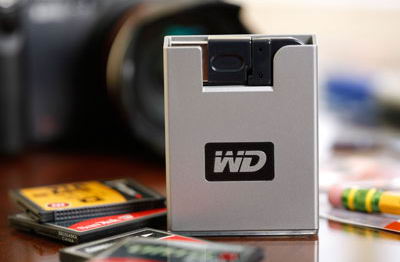 but also a consumer product - a miniature 6 GB external storage drive WD Passport Pocket Drive USB 2.0. It will be examined in this article. By the way, we have never reviewed WD products for this segment, so it will be our first encounter with WD in this sphere. 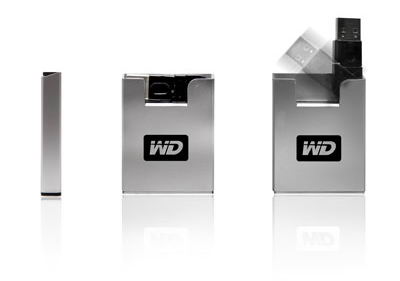
Exterior, Specifications and DesignA full official name of this "kid" is WD Passport Pocket Drive WDXMM60WPE, WD60W028 model. The word "pocket" (even if Passport :)) in the title is fully justified — dimensions of the plastic case are just 61.1×45.7×9.5 mm, 50 g.  Compared to most other counterparts, WD Pocket Drive is probably the most compact and certainly the thinnest device. Differences from the tubby Seagate ST650211USB are especially noticeable. It's not much larger than some USB flash drives from the recent past. But it houses a convenient flip-out USB plug. 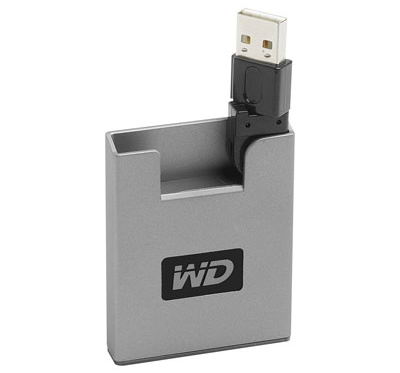 A flip-out USB plug is a usual thing in storage drives of this class. But the one in WD Pocket Drive can also rotate by 90° both ways. So it's very convenient to use with various notebooks and compact PCs. By the way, this plug works in any position (different from 90°), because it's connected to the device with flexible wires. 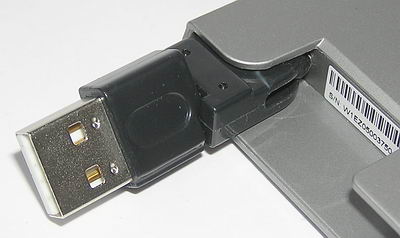 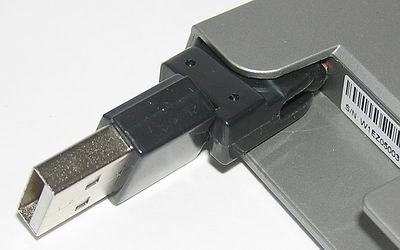 The case is made of thick (1.5 mm) white plastic covered with silver paint. You shouldn't worry much about its chafe-resistance, because the bundle includes a semitransparent rubberized sleeve WDCC03 (also acting as a shock-absorber). There is no need to remove the device from it even when you use it. 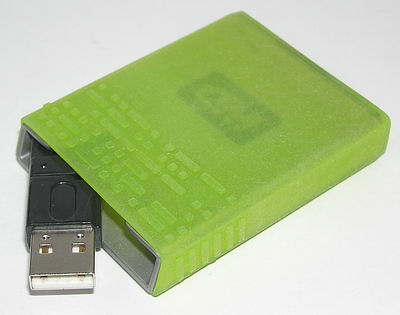 Thickness of the device in a sleeve grows to 12 mm. Unit-cast case has only two end-caps: one for the USB plug (with a slot for wires), and the other one (transparent at the sides) for the opposite side. Two blue LEDs shine through the latter to indicate readiness and activity of the hard drive. Theoretically, you can disassemble the case (but I wouldn't advise to do it): end-caps are latched to the case and can be removed with a scalpel. 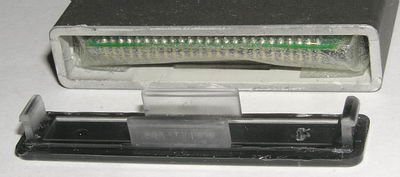 After that you should unscrew the inner part of the USB plug, remove it and take out all innards with remains of the plug on the opposite side (opposite to USB). Inside you will find a WD60WP-32LPV0 hard drive with the CF+ Type II connector, 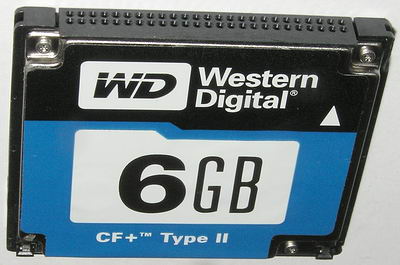 secured on a thin PCB with all radio elements on the back side, including voltage converters. 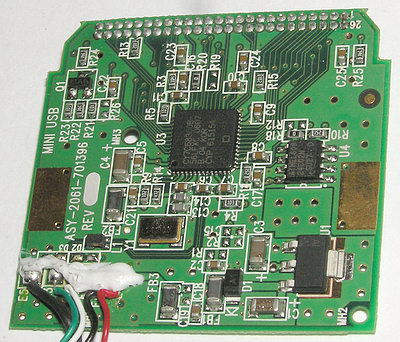 The heart of the interface controller is the CY7C68300B chip - we have already seen it in some 2.5" USB drives (for example, WD Passport 120 GB). This controller offers sufficiently high performance. Theoretically, it must not be a bottleneck in the signaling circuit.  The board with the hard drive is wrapped with a thick scotch-tape to give additional protection from shocks and to secure internal components in the enclosure. The drive is also secured with rubber pieces at its ends. The WDT-WD60WP hard drive has the rotational speed of 3600 rpm (average latency - 8.30 ms), 2 MB buffer, average seek time - 11 ms (1.0 ms between neighboring tracks), and formatted capacity of 6144 million bytes (5.7 GB in Windows). It does not break any records these days. We even heard that WD was preparing a 8 GB counterpart of this model. But it may be just a plan. The official range of operating frequencies of WD Pocket Drive is from +5° to +35° (the top limit is too low for tropical countries). The device can be stored from -40° to +70°. WD Passport Pocket Drive comes in a "disposable" transparent plastic package with telltale labels on the back side. Along with the device and a rubberized sleeve (by the way, it's available on the WD web site for $19.99), the bundle includes only a Quick Installation Guide in many languages. According to the manufacturer, the device is compatible with Windows 98SE/Me/2000/XP, MacOS 9.2.2, MacOS X 10.2.8, and newer. The bundle does not contain drivers for old operating systems (like Windows 98SE), but the storage drive is initially formatted as FAT32. However, the manual recommends to download these drivers from WD Service and Support Site (ID 1286 in Knowledge Base). The drive contains WD Sync and WD Diagnostics utilities, which we already reviewed in the previous review of WD Passport. In particular, WD Sync does not require installation and allows to sync data and user settings (using 128-bit AES encryption), when you work on several PCs with this drive. For example, you can connect WD Passport to some PC when you travel, run WD Sync, and get access to your information in your custom environment. When you return home, you can quickly merge the changes you made to your PC, protected from unauthorized access.
Performance testsWe'll compare this model with a 5 GB Seagate USB 2.0 Pocket Hard Drive ST650211USB of the same class manufactured in the end of 2004, as well as with 2.5" WD Passport 120 GB. We have tested WD Passport Pocket Drive in the extended mode: with both options for caching data for writing in Windows (cached and quick removal) and with both file systems — default FAT32 and modern NTFS5. We have run our tests on the following testbed:
The drives were connected to the USB 2.0 controller on this motherboard. The tests were carried out under MS Windows XP Professional SP1. We'll again analyze not only primitive performance characteristics of our contenders (buffered, linear, and random access rates), we'll also pay attention to practical (real) aspects of external drives, because the above mentioned characteristics cannot give an adequate picture of the real day-to-day situation (running applications, writing data, reading and copying files, etc) with hard drives from various manufacturers with various characteristics and most importantly with various firmware algorithms. Let's proceed to test results. The average access time of WD Passport Pocket Drive is rather high — even a tad higher than that of the similar model from Seagate. It's certainly much higher than that in 2.5" external storage drives and most flash drives. We were also disappointed by the Hi-Speed USB interface transfer rate in WD Pocket 6 GB — even though it uses the "time-proven" controller, the USB interface transfer rate is just one third of the interface potential. It's much lower than in competing products from Seagate and some other devices of this class. But we should note that it's even worse in 1" external storage devices Archos ARCdisk 4 and MSI Mega Cache. Results of the Transfer Rate test in WinBench 99 are published on the following diagram. 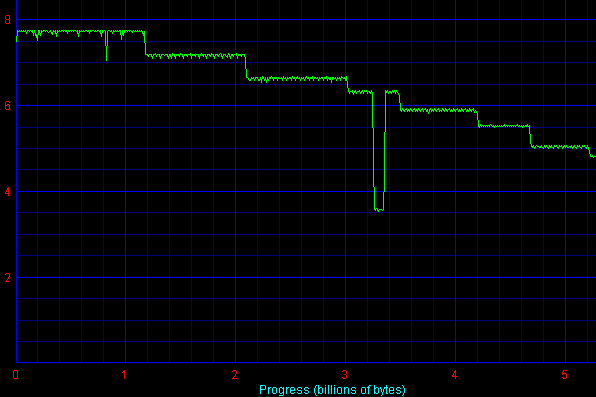 You can see that the linear reading rate of our model under review is slightly below 8 millions of bytes per second. And besides, the 1" storage drive from Seagate (5 GB) manufactured two years ago offers even a tad higher average linear read rate (see the next graph). A single curve dip on the WD Pocket graph is an artifact that has to do with the quality of a given sample. Another sample of the same model demonstrated noticeably more curve dips (although it worked just fine), so we did not risk using it for performance tests. Multithreaded write test in NBench, averaged by our traditional patterns (from one to four simultaneous threads), shows that WD Pocket Drive 6 GB demonstrates acceptable multi-threaded performance with large files. NTFS evidently has some advantage over FAT32. On the whole, Windows caching has a positive effect. The same applies to multi-threaded reading. WD Pocket Drive demonstrates quite high results in WinBench 99 Disk WinMark compared to the Seagate competitor. Some time ago such results were also demonstrated by desktop drives. Now even this tiny device is up to them. There is a strange exception of NTFS, where performance of the drive in the business test even with disabled Windows caching (we checked it out) does not slump, unlike all other cases. By the way, WD Passport demonstrated much better results in FAT32 with caching. We also noticed anomalous fast performance of the drive with NTFS without caching in the High-End test. Remember that a similar tendency was demonstrated by WD Passport 120 GB that uses the same controller. The difference between storage drives of various classes in PCmark04 is also evident, but not critical. It corresponds to their differences in transfer rates. File Copy Average Performance results in AVI, MP3, JPG and WEB patterns for operations within tested drives (you can evaluate file copy performance from outside a drive by test results of multi-threaded writing and reading) are published on the detailed diagram. You are recommended to enable Windows caching when you copy lots of small files, or it will take much time. But caching is almost useless in case of large files. The diagram with geomean performance results for copying files does a better job of illustrating the difference between drives of different classes — it's almost tenfold with caching! Detailed File Archiving (with zero compression) and Extracting Performance results (for example, extraction, installation from a package or archiving/packing files) are published on a separate page. Average results of drives in this test are published below. The speed obviously grows in case of Windows caching, and NTFS provides better performance — especially with disabled Windows caching.
Power ConsumptionCompact dimensions, capacity, GB cost, and performance are not the only consumer characteristics of a USB drive that matter. Power consumption is also an important characteristic of a pocket drive, if you have to plug it to notebooks or other compact USB hosts. We've measured typical power consumption values of the drive in various modes: idle (just spinning), read, write, active seek, interface operation, power up, etc. These readings are published in the table, which compares them with usual 2.5" hard drives (4200 rpm) and a typical USB 2.0 flash drive. Here: Idle — the drive is spinning (but no data are accessed); Pre-idle — it's an active mode that lasts several seconds after the access mode is finished before going idle (perhaps the heads are not parked yet) ATA Transfer — data are transferred via the ATA bus without accessing a platter; Seek — active seek mode (chaotic movements of the heads across the entire platter); Start — maximum current drain at start-up (averaged by the time constant of 0.1 sec). Read and write results are published for the power consumption range — the first figure corresponds to beginning (outer tracks) of the disk, the last — to the end of the disk. All modes but Start were measured during corresponding stages of AIDA32 Disk Benchmark. Current drain (mA) of storage drives on the +5V line measured in various modes.
Thus, idle power consumption of WD Pocket Drive WDXMM60WPE is very low — much lower than in other hard drives, even lower than in some flash drives (you can also consider results of similar products in the other review on our web site)! At the same time, our model under review cannot boast of any power consumption records in active modes: its read, write, and seek results as well as startup current are approximately on the same level as in a similar 5 GB drive from Seagate (made two years ago). These data are used to calculate typical power consumption for two usage patterns: The average power consumption of drives for typical and intensive (constant) disk usage.
WD Passport Pocket Drive WDXMM60WPE is evidently no less economic than USB flash drives in the typical usage model. But it's much more voracious in intensive disk operations, it's approximately on the same level with models using 1" drives.
Acoustic noiseYou'll have to try very hard to hear this drive. :) But light cracking of heads is audible, if you are in a quiet room. So you will always know when the drive is working. ;)
ConclusionOn the whole, WD Passport Pocket Drive WDXMM60WPE justifies its mission. Providing good capacity at an affordable price (for example, 8 GB Seagate storage device of the same class costs over $170), it's notable for compact size (even compared to its competitors), economy, and it sometimes demonstrates good performance, although not the best (considering the advance of high-capacity flash drives). The recent drop of prices for flash memory (for example, an 8 GB CF card can be bought for $90) actually gives the future of 1" hard drives and USB drives up for lost - possessing much better reliability, shock resistance, and higher performance, they bring to nought the old advantages of microdrives in price and maximum capacity. We should only wait for the appearance of appropriate USB drives of this capacity in stores. Perhaps it's time to establish the fact that hard drives have lost another bastion under the flash pressure. And IBM microdrive will leave fond memories of itself. :)
Write a comment below. No registration needed!
|
Platform · Video · Multimedia · Mobile · Other || About us & Privacy policy · Twitter · Facebook Copyright © Byrds Research & Publishing, Ltd., 1997–2011. All rights reserved. |